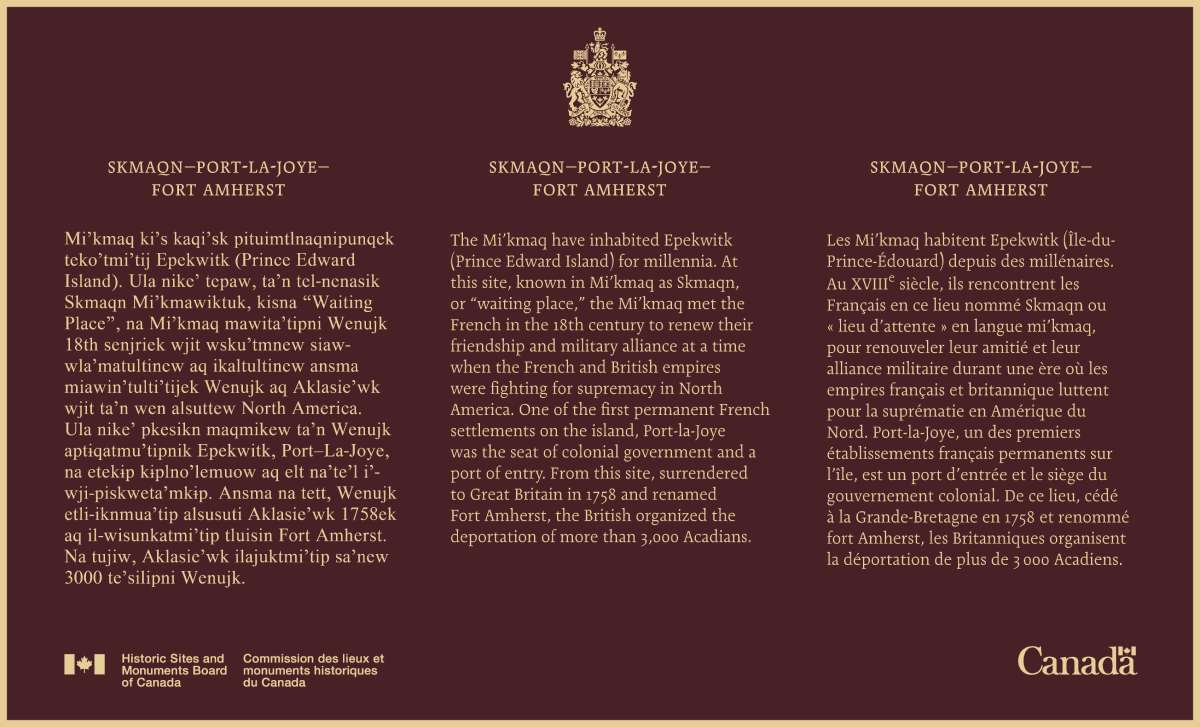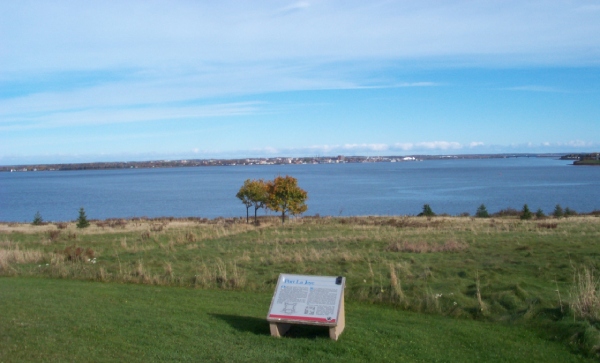Skmaqn–Port-la-Joye–Fort Amherst National Historic Site

© Parks Canada. All rights reserved.
Skmaqn–Port-la-Joye–Fort Amherst was designated as a national historic site in 1958.
Commemorative plaque: will be installed at 191 Haché Gallant Drive, Rocky Point, Prince Edward IslandFootnote 1
Skmaqn–Port-la-Joye–Fort Amherst
The Mi’kmaq have inhabited Epekwitk (Prince Edward Island) for millennia. At this site, known in Mi’kmaq as Skmaqn, or “waiting place,” the Mi’kmaq met the French in the 18th century to renew their friendship and military alliance at a time when the French and British empires were fighting for supremacy in North America. One of the first permanent French settlements on the island, Port-la-Joye was the seat of colonial government and a port of entry. From this site, surrendered to Great Britain in 1758 and renamed Fort Amherst, the British organized the deportation of more than 3,000 Acadians.
Skmaqn–Port-la-Joye–Fort Amherst
Mi’kmaq ki’s kaqi’sk pituimtlnaqnipunqek teko’tmi’tij Epekwitk (Prince Edward Island). Ula nike’ tepaw, ta’n tel-nenasik Skmaqn Mi’kmawiktuk, kisna “Waiting Place”, na Mi’kmaq mawita’tipni Wenujk 18th senjriek wjit wsku’tmnew siawwla’matultinew aq ikaltultinew ansma miawin’tulti’tijek Wenujk aq Aklasie’wk wjit ta’n wen alsuttew North America. Ula nike’ pkesikn maqmikew ta’n Wenujk aptɨqatmu’tipnik Epekwitk, Port–La-Joye, na etekɨp kɨplno’lemuow aq elt na’te’l i’- wji-piskweta’mkɨp. Ansma na tett, Wenujk etli-iknmua’tip alsusuti Aklasie’wk 1758ek aq il-wisunkatmi’tip tluisin Fort Amherst. Na tujiw, Aklasie’wk ilajuktmi’tip sa’new 3000 te’silipni Wenujk.

Skmaqn–Port-la-Joye–Fort Amherst
The Mi’kmaq have inhabited Epekwitk (Prince Edward Island) for millennia. Skmaqn‒Port-la-Joye‒Fort Amherst was the site of the Government of Île Saint-Jean/Saint John’s Island from 1720 to 1768, initially under the French regime, then under the British regime. This was the port of entry for newcomers who came to settle on the island. Port-la-Joye, or Skmaqn, as it is known in Mi’kmaq, was where Mi’kmaq and French dignitaries met to renew their friendship and military alliance. The site was also a battleground for the struggle between the French and the British for supremacy in North America. During the British occupation, it was renamed Fort Amherst, and it was from here that the forcible removal of more than 3,000 Acadians from the island was organized in 1758.
Skmaqn, located at the meeting point of waterways linking Epekwitk with Mi’kma’ki (the territories of the Mi’kmaq), was chosen by the French as their base in the region. The French established a colony on Île Saint-Jean in 1720 that was administered from Port-la-Joye. That year, 300 men, women, and children arrived from France to settle on the island. They were soon joined by some Acadian settlers. Relationships based on trade and religion developed here and extended to military alliances between the Mi'kmaq and the French Crown, who collaborated in conflicts against the British. Port-la-Joye played a vital role as a site for alliance renewal ceremonies between the Mi’kmaq and French leaders. In times of peace from 1726 to 1744 and 1749 to 1755, the Mi’kmaq from the entire region gathered annually to await the arrival of the French at “Skmaqn,” which means “waiting place.” These meetings were intended to maintain and strengthen the alliance and, for the French, to obtain information on British activities in the region.

© Parks Canada

© Parks Canada
While Port-la-Joye had a garrison, the military presence on Île Saint-Jean was minor. Following the fall of Louisbourg in 1745, 300 soldiers from New England attacked Île Saint-Jean, burning houses and destroying crops. The Treaty of Aix-la-Chapelle in 1748 returned Port-la-Joye to the French, but shortly after Louisbourg fell again to the British in July 1758, Port-la-Joye and Île Saint-Jean capitulated, ending the period of French administration.
The British built Fort Amherst close to the site of Port-la-Joye in 1758. In the weeks that followed, British soldiers assembled 3,000 French and Acadian men, women, and children from Île Saint-Jean here to deport them to France. Their passage to France was dangerous as several vessels sank and onboard illness was common; an estimated 1,649 individuals, over half of those deported, died before they reached France. Ten years later, the British established their capital at Charlottetown, across the harbour, and dismantled the fort.
This site was designated in 1958 and originally named Fort Amherst National Historic Site. In 1985, its name was changed to Fort Amherst/Port-la-Joye and in 2018, it was officially renamed Skmaqn‒Port-la-Joye‒Fort Amherst.
This press backgrounder was prepared at the time of the Ministerial announcement in 2023.
Description of historic place

© Parks Canada
Skmaqn–Port-la-Joye–Fort Amherst National Historic Site of Canada is a remnant 18th-century fort built by the French and later occupied by the British in a strategic location on a height of land overlooking Charlottetown harbour and several rivers. Situated on the west side of the channel entrance to Charlottetown harbour, it is a landscape of gently rolling hills with remnants of a fort earthworks, of an early settler’s house, of at least three other French / Acadian farms, and of the French garrison, as well as 19th- and 20th-century facilities. Official recognition refers to the limits of the property currently owned and administered by Parks Canada.
Heritage value
Skmaqn–Port-la-Joye–Fort Amherst was designated a National Historic Site of Canada in 1958. It is recognized because:
- from 1720 to 1770 it served as the seat of government, first for the French and later for the British, and port of entry for settlers to the island;
- it was a colonial base of importance for France, a location where Mi’kmaq and French leaders renewed their close relationship, a place of conflict in the English-French struggle for dominance in North America, and the forcible removal of 3,000 Acadians from the island in 1758 was overseen from Fort Amherst;
- the removal was the largest and most tragic of all the many Acadian deportations that occurred between 1755 and 1762.
The heritage value of the site resides in its long history related to the struggle for colonial dominance involving the original Mi’kmaq residents of the island, the French, and later the British. It is illustrated by its setting with remnants of the fort and evidence of French and British military occupancy as well as early Acadian settlement. Port-la-Joye was established as headquarters for the French protection, trade and administration of Île Saint-Jean in 1720. Despite being abandoned and captured by the British several times between 1720 and 1758, Acadians established farms in the surrounding area, and the French built a Vauban-style star-shaped fort in 1748-1758. A former farm belonging to Michel Haché-Gallant is still visible. After the British added a rectangular earthwork in front of the fort and called it Fort Amherst, it remained the major administrative centre for Prince Edward Island until 1770.
Sources: Historic Sites and Monuments Board of Canada, Minutes, June 1958 and December 2008 ; Status of Designation (SDC) Minutes, September 2016 and December 2017 ; Commemorative Integrity Statement, June 1997.
The National Program of Historical Commemoration relies on the participation of Canadians in the identification of places, events and persons of national historic significance. Any member of the public can nominate a topic for consideration by the Historic Sites and Monuments Board of Canada.
- Date modified :